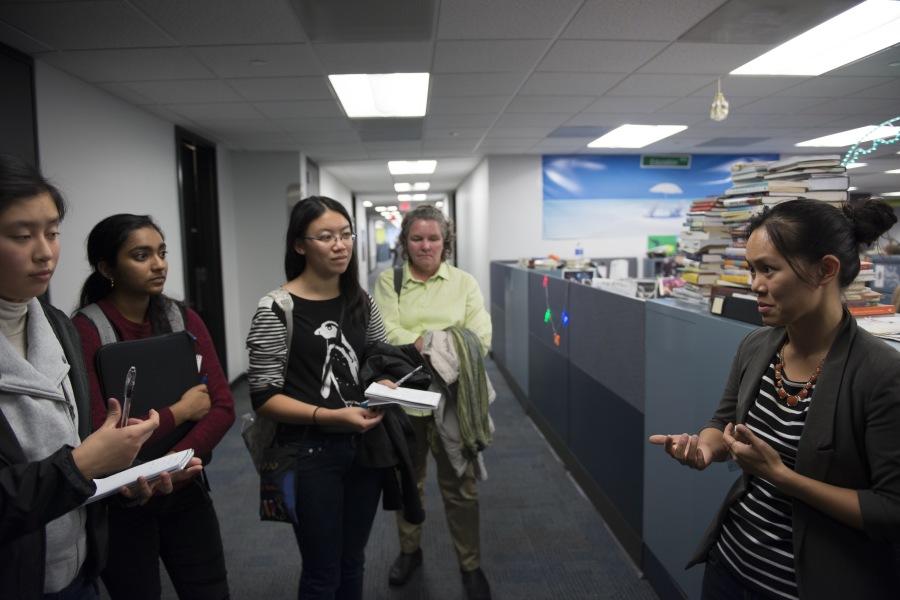Alum discusses journey to journalism career at Washington Post
November 7, 2014
Emily Chow (’08) offers final words of advice to seniors Jessica “Fred” Chang, Apoorva Rangan, and Kacey Fang. Students were encouraged to ask questions throughout the tour about her personal and professional experiences as a Harker alumnus.
Standing in front of what seemed to be an interminable mass of cubicles sporadically populated with men and women staring at their device screens or engaging in intense conversation with one another, she smiled widely and spread her arms to her sides.
“Welcome to the newsroom,” said Emily Chow (‘08), Graphics Designer of the Washington Post.
Clad simply yet smartly in a grey blazer, striped black and white shirt adorned with an orange necklace, jeans and olive green boots, Chow grinned and spoke easily when addressing her role at the Post, the paper’s processes, and her own journey from the Harker Upper School to the Post position where she currently operates.
Chow led the way to the north wall of the building, where two managing editors and the executive editor of the Post have their offices. She introduced Lee Hockstader, an editorial writer and member of the Post’s editorial board, and James Downie, the Digital Opinion Editor. Both spoke at length about the editorial process and the future of journalism for students.
She then showed the way to her own section’s area, leading the way across the fifth floor through section after section, as the education pod blurred into the political blogger section and into economics and more. Her own cubicle’s counters were covered with keepsakes, two computers, and other paraphernalia, and the bulletin board along her wall was tacked over with cards and flowcharts, a mix of seriousness and humor.
She walked over to the photojournalism table and laid out her experiences and reflections on her position at the Post.
Chow was a Harker journalism staff member for all four years of high school under former journalism advisor Chris Daren.
“I spent a lot of time in the visual aspects of journalism and yearbook,” she said.
She attended Northwestern University’s Medill School of Journalism, Media, Integrated Marketing Communication in the class of 2012. She recalls also working for the Office of Communications, shooting summer photos for the Harker Quarterly. In the summers between her years of college, she worked as an intern at Sunset magazine, Chicago Tribune, and finally the Washington Post.
Next, she discussed the infographics team.
“We bridge everything, if you’re talking about skillsets. Everyone in this team is talented,” Chow said.
She referred to members of the section as “people who can tell a beautiful story.”
“We ask the question, ‘what is still missing that we can provide?’” she said of the infographics process.
Chow was introduced to coding interactive graphics online from an older classmate at Northwestern.
“It kind of brought a whole new light to journalism,” she said. “It changed what I realized you could do.”
Chow’s primary hurdles in infographic design lie in how the Post’s userbase consumes material across devices in different ways, remarking on the growing uses of tablets and smartphones to view Washington Post material as compared to laptops and desktop computers.
“I don’t think they’re limitations,” she said. “I think they’re challenges.”
Though she admitted that she does not always have time to pursue other hobbies at length— “Journalism is a full-time job,” she quipped—rock-climbing, baking, or leisure reading, Chow insisted that her work on graphics is what she prefers to do most of the time.
Chow also mentioned the ongoing plans of redesigning the online pages for more readability and interactivity, referring to the current process as a “rethink.”
“Redesigning the website is not about redesigning the website,” she said. “You have to change the entire workflow to improve the experience behind it.”
A quick look around the fourth floor of the newsroom and a few parting words of advice from Chow concluded the tour.
“Stay curious,” she said to the group of high school journalist-hopefuls looking up at her from the table. “Life should not always be taken seriously.”
Chow, currently two and a half years into her professional career, expressed her current contentment at the Post with her team as well as the variability of the long future ahead of her.
